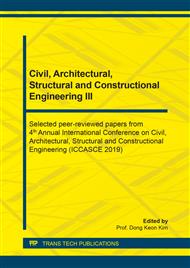p.190
p.195
p.202
p.211
p.221
p.226
p.231
p.239
p.245
Materials Science Introduces Disaster Prevention and Mitigation Education Experiment
Abstract:
This study used 700 children under the age of 11 as the research target for materials science introduces disaster prevention and mitigation education. The purpose of this study is to training and popularize the scientific knowledge literacy of disaster prevention, and to design disaster prevention and mitigation education through the diversity of material science. This study will carry out the learning outcome experiment of scientific concept and spontaneous concept into the disaster prevention science popularization education. Hope to study through teacher training courses, life science practice activities and digital learning application experiments. The study integrates material science disaster prevention course and campus science education, and 15 material science experiments were planned to be applied to the evaluation of the learning outcome of disaster prevention and mitigation experiments. Before the experiment, teachers were guided by disaster prevention science education, and after 12-year-old children relayed the principles of science, they assisted 6 to 11-year-old students to operate materials science experiments and analyze the learning outcome. Through simple teaching design and multi-level pre-teaching can effective promotion 36.5% of student's interest in material science used in the field of disaster prevention and mitigation, and by 73% of student aged 9 to 11, they can be more effectively improved the strategy and purpose of disaster prevention and mitigation education by dictation of their disaster prevention and mitigation education related to family, peers and living environment.
Info:
Periodical:
Pages:
221-225
Citation:
Online since:
April 2020
Authors:
Keywords:
Price:
Сopyright:
© 2020 Trans Tech Publications Ltd. All Rights Reserved
Share:
Citation:


